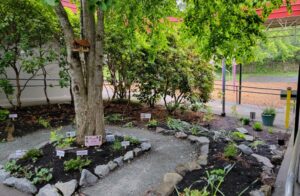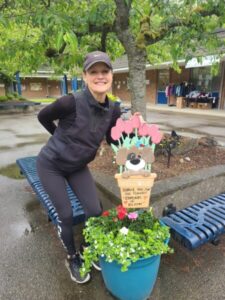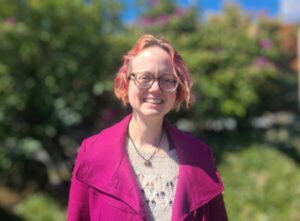
Health Matters: Area’s increasing density prompts gardeners to get creative growing in small spaces
This is the second of a five-part “Health Matters” series focused on health topics in South Snohomish County and sponsored by the Verdant Health Commission. Read part 1 — “As county’s demographics change, immigrants struggle to access health care” — here.
The sliver of land on the side of Val Taylor’s Lynnwood home is narrow and shady, but that didn’t stop her from creating a thriving green space there. Lush vines and fragrant plants spill out of clay pots, copper bowls and a French urn.
“When I moved here, this area was nothing,” she said, as she used a hose to spray a gentle mist over what’s now a corridor of snap peas, raspberries and apple blossom roses. “I don’t even think it’s 3 feet wide.”
Taylor isn’t the only local resident who is transforming tiny, forgotten spaces into bountiful gardens. As the region’s housing density increases, more people are turning to container gardens on patios and balconies, or growing their greens in community spaces like churches and schools. At the same time, burgeoning grocery bills and a desire for organic produce are creating demand more for personal gardens. The interest in small-space gardening is so strong that Snohomish County Master Gardener Program developed a “container garden” demonstration plot this year to show just how easy and affordable it can be.
 The Edmonds College plant sale was bustling on a recent morning with customers eager to fill their summer gardens. Tomato plants were among the hottest items, staff said. (Photo by Nick Ng)
The Edmonds College plant sale was bustling on a recent morning with customers eager to fill their summer gardens. Tomato plants were among the hottest items, staff said. (Photo by Nick Ng)
“There’s a real interest in container gardens in part due to the increasing density of urban areas,” said Master Gardener Karen Schneider, who worked on the demonstration garden. “You can place containers in the sun, control the soil and manage the environment a lot more effectively.”
Small gardens a response to myriad factors
Overall, the Puget Sound region is expected to grow by 830,000 households by 2050. That increasing density is already transforming how people view space – and greenery. Gone are the days when a garden required a spacious, sun-filled backyard.
“Look at Edmonds: How many condos are there?” Schneider said. “New homes are being built with a quarter of the space. There’s a whole new generation coming up that has less space and wants to garden.”
Other factors are in play, too, encouraging people who might not otherwise have considered gardening to give it a go. Grocery bills have skyrocketed with inflation and people are feeling the squeeze. There are also growing concerns about the impact of one’s carbon footprint on climate change. Other residents are worried about the health impact of pesticides and want more control over what’s on their plate. Immigrant communities may want to grow hard-to-find culinary plants, and parents want to show their kids that produce doesn’t come from a grocery store shelf.
“All of those things are coming together,” Schneider said. “People are looking at: How can I do this?”
Demonstrating the possibilities
 Container gardens can be created with all kinds of materials, including old bricks and rocks. (Photo courtesy Karen Schneider)
Container gardens can be created with all kinds of materials, including old bricks and rocks. (Photo courtesy Karen Schneider)
At the Master Gardeners’ Jennings Park Demonstration Garden in Marysville, Schneider used recycled materials to showcase the myriad possibilities of tight spaces – and budgets. She’s growing veggies in donated horse water troughs and inexpensive fabric bags. There’s an entire garden bed constructed with found materials: leftover bricks, rocks and concrete slabs. She also utilizes a lightweight metal “Vego” bed which can be assembled in an hour.
The goal is to remove some of the limitations people face when considering a garden, whether it be space, budget or simply the hurdle of getting started. Approachable samples like these ease people into gardening.
“If people could see something small and manageable, they think: ‘I can do this,’” she said. “Then they have success with a small container and do more.”
So far, passersby have responded with curiosity, asking if they can take pictures or requesting the names of certain plants. Ultimately, Schneider hopes to label the plants, and share information on just how much food can be grown in a small space – and the impact on someone’s food budget.
“If you don’t have to buy lettuce and tomatoes all summer, what a huge savings,” she said.
Communal patches provide opportunity

Ruseline Ariaga, who gardens at the Edmonds Lutheran Church, said she enjoys sharing her bounty with friends and family. (Photo by Kellie Schmitt)
Shared gardens are another way to expand garden accessibility. Throughout the county, there are dozens of churches, parks, food banks and schools where people can grow in shared spaces, according to the WSU Snohomish County Extension’s compilation. (See our related story about Trinity Lutheran’s community garden here.)
Ruseline Ariaga was fresh off the night shift and taking a morning walk when she discovered the “Pea Patch” at Edmonds Lutheran Church. Ariaga was drawn to the rows of wooden container gardens and asked if she could cultivate her own plot there. For Ariaga — a resident of a nearby apartment complex — gardening had previously felt out of reach.
Several years later, the four beds she tends are filled with kale varieties, as well as edible black nightshade, which is a familiar plant in her native Kenya.
“It gives me happiness when I see my crops growing well,” she said, as she bent at the waist and pulled stray grasses from the garden’s borders. “I feel so energetic.
 Pete Wolcott begins his day on a healthy note, pulling weeds from his shared patch at Edmonds Lutheran Church. (Photo by Kellie Schmitt)
Pete Wolcott begins his day on a healthy note, pulling weeds from his shared patch at Edmonds Lutheran Church. (Photo by Kellie Schmitt)
Fellow community gardener Pete Wolcott said the planting and upkeep also energizes him. He keeps up a regular morning gardening schedule, clearing the weeds around a patch bursting with frilly Bearded Irises.
“I feel the best I feel all day when I’m in the garden,” he said.
Small gardens springing up at schools
 Chase Lake Elementary teacher Ranya Khalil says the school’s container gardens offer hands-on learning experiences and expose students to new vegetables.
Chase Lake Elementary teacher Ranya Khalil says the school’s container gardens offer hands-on learning experiences and expose students to new vegetables.
That’s a sentiment that local educators are hoping to cultivate in schools, too. Creating school gardens in small, shared spaces provides health and wellness benefits to students who might not otherwise experience gardening. Amid tight budgets, the schools are looking to organizations like the Edmonds Floretum Garden Club, which financially supports local school gardens.
On a recent Friday afternoon, Floretum member Dorothy Lindstrom joined Chase Lake Elementary School teacher Ranya Khalil to check out the school garden’s new drip-watering system. Along with grade-specific projects, Khalil also organizes gardening work parties so families can join in.
The appetite among students is strong. After she offered radishes samples to students, she raffled off the remaining six for lucky winners to take home. Khalil intentionally grows culturally-relevant produce that are recognizable to a diverse student body, such as bok choy, cilantro and rue, an herb used in Ethiopia.
 Cedar Way Elementary’s garden helps improve learning while also strengthening students’ health and wellbeing, teachers say. (Photo courtesy Stacy Stuehrenberg)
Cedar Way Elementary’s garden helps improve learning while also strengthening students’ health and wellbeing, teachers say. (Photo courtesy Stacy Stuehrenberg)
Students at Cedat Way Elementary School in Mountlake Terrace have expressed similar enthusiasm for their first introduction to gardening. A high proportion of the students live in apartment complexes where there isn’t growing space, explained first-grade teacher Stacy Stuehrenberg. The school’s new outdoor container gardening area gives students the chance to engage in hands-on science – such as observing how worms decompose lunch scraps and how those help create soil nutrients – and ultimately, sweet, fresh carrots.
“It’s really empowering to know they’ve also had a part in setting that ecosystem up,” she said. “It’s a living lab where you can go out and make observations directly related to the science standards.”
 Sherwood Elementary physical education specialist Pamela Thain said caring for plants is a coveted job at the school.
Sherwood Elementary physical education specialist Pamela Thain said caring for plants is a coveted job at the school.
The learning extends beyond science. At Edmonds’ Sherwood Elementary School, a scattering of small planters bursting with colorful flowers has helped students cope with the day’s stressors. Physical education specialist Pamela Thain invites students to deadhead old flowers and water the planters that line the school’s entrance and courtyard. Caring for the plants is a coveted job, one that instills pride in their school as well as self-confidence, she said.
“If kids are having a hard day, the teachers will ask if they can come help,” Thain said. “It makes them feel good about themselves.”
She hopes the exposure will help create a lifelong love of gardening, one that can keep them active well past their years running around the playground.
“They won’t be playing soccer when they’re 95, but they can garden when they’re 95,” she said.
Health, wellbeing motivate local gardeners
 Eating something you’ve grown with your own hands makes it taste that much better, home gardeners say. (Photo by Kellie Schmitt)
Eating something you’ve grown with your own hands makes it taste that much better, home gardeners say. (Photo by Kellie Schmitt)
Indeed, the benefits of gardening extend beyond a bountiful harvest. Gardens and gardening “can improve the health and well-being for people with a range of health and social needs,” according to a review of dozens of peer-reviewed studies published in 2020 in BMJ Open. In fact, the benefits are so strong they could be used as a “social prescription” for people with long-term conditions, the paper found.
“There’s nothing more rewarding than growing healthy plants,” said Lorraine Brooks, the department head for horticulture at Edmonds College.
Brooks points to research demonstrating gardening as a way of helping people with dementia as well as their caregivers. Other studies have looked the health benefits of working with soil – and the exposure to the diverse microbes present in dirt. There is also research looking at gardening’s impact on cardio health as well as the mental health benefits that come via stress reduction.
“Unless you have a lot of weeds – that can be stressful,” Brooks said with a laugh.
Local gardener Jackie Trimble said she relishes the mental health boost that comes from seeing a plant grow and flourish. Eating something you’ve grown with your own hands makes it taste that much better – for children as well. Her youngest son didn’t like vegetables when he was a child. That changed when he helped Trimble plant carrots and green beans.
“I found him in the garden pulling carrots up, picking green beans off and eating them raw,” she said. “Now, he loves vegetables.”
 Mary Kimball, the president of Edmonds Floretum Garden Club, has gardened in small spaces, including a balcony and a rooftop. She recommends that people think carefully about which small space works best for their lifestyle and pick a convenient space. (Photo by Kellie Schmitt)
Mary Kimball, the president of Edmonds Floretum Garden Club, has gardened in small spaces, including a balcony and a rooftop. She recommends that people think carefully about which small space works best for their lifestyle and pick a convenient space. (Photo by Kellie Schmitt)
For Mary Kimball, the president of Edmonds Floretum, gardening has improved her overall wellbeing through social connections. She moved to the area from California about nine years ago and was confronted with the “Seattle Freeze,” the phenomena referring to the difficulty making friends here. When she joined the club, she was struck by the welcoming people and the meaningful connections she developed through a shared love of growing. The group gatherings provide stability and create predictable social outlets.
“It’s through connecting to people that you can stay grounded and connected to the world at large,” she said.
The social and emotional benefits are clear with the area’s youngest residents, too, says Todd Stuehrenberg, a sixth-grade science teacher at Cedar Way Elementary.. You can under or over water a plant and watch it bounce back. That’s an important lesson on resilience, which seems even more relevant to youth emerging from a pandemic.
He hopes the school’s container gardens help students understand that gardening can and should be accessible to everyone. You can garden in something as simple as a plastic yogurt cup, he notes.
“It doesn’t take much,” he said. “You can get some plants growing in a pretty small space.”
How to grow in small spaces
Local gardeners share advice, tips Fabric grow bags, like these found at a community plot in Shoreline, provide an easy and affordable option for people gardening in small spaces. (Photo by Kellie Schmitt)
Fabric grow bags, like these found at a community plot in Shoreline, provide an easy and affordable option for people gardening in small spaces. (Photo by Kellie Schmitt)
Containers: A variety of containers can work in small spaces. Start with any pot that has drainage holes. Fabric grow bags can work, too, since the excess liquid can drain out of the fabric. Horse troughs can be pricey when new, but can often be found second-hand. If a container doesn’t already have holes, you can drill them yourself.
Soil: Start with a basic potting soil blend. For the first season, that should be sufficient. If you plan to reuse the containers year after year, consider adding some compost or fertilizer to boost soil nutrients.
Water: When growing in containers, consider your water source. Try to place the containers somewhere convenient where you can easily carry a watering can or connect to a spigot.
What to grow: First and foremost, consider what you want to eat. Leafy greens like lettuces, and spinach are a good place to start and can withstand cooler temperatures. Pole and bush beans make good use of small spaces since they grow vertically. Strawberries in a hanging basket may be a good fit if you’re gardening on a balcony. For a basic beginner sampler, try filling a 12-inch pot with a tomato plant, lettuces, basil and edible flowers. Fresh herbs are another great choice for small spaces. Try oregano, thyme, mint, basil, cilantro or parsley.
Pests: Container gardens make it easier to avoid pests like slugs. If you do have birds or bunnies snacking on your veggies, cover the garden with netting, or try planting strong-smelling marigolds and green onions around the perimeter as a natural deterrent.
Timing: Be mindful of when you plant. Just because a store is selling a plant doesn’t necessarily mean it’s time to plant it. Some heat-lovers like tomatoes might struggle if they’re planted too early. Organizations like the Tilth Alliance publish local guides such as the “Maritime Northwest Gardening Guide” or check out the WSU Extension Master Gardener resources.
Questions: Snohomish County Master Gardener Program has a hotline for people to call asking garden-related questions at 425-357-6010 or in person at their office at Willis Tucker Park. The Tilth Alliance also operates a garden hotline at 206-633-0224. For people who want to learn more in person, consider one of Edmonds College’s Horticulture Department’s numerous gardening-related classes.
— By Kellie Schmitt
Kellie Schmitt is an award-winning health reporter based in Edmonds. She covers health policy, public health and children’s health for a variety of publications including the Johns Hopkins University Public Health Magazine, ParentMap, and USC’s Center for Health Journalism. She has a master’s in science writing from Johns Hopkins University.
This series is supported by funding from the Verdant Health Commission. The My Neighborhood News Network maintains full editorial control over content produced as part of this series.
